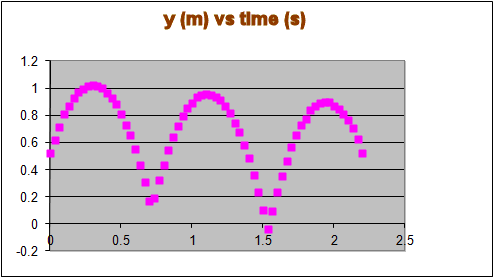
Energy conservation for an isolated system is a fundamental principle of
physics. Energy for an isolated system is always conserved. It may change
forms, but the total amount of energy in an isolated system is constant.
Energy can, however, be converted from one form to another form. Work is the conversion of one form of energy into another.
Energy comes in different forms, kinetic energy, potential energy, chemical
energy, thermal energy, etc. If an object has energy, it has the potential
to do work.
There are several forms of potential energy. Kinetic and potential energy
are called mechanical energy or
ordered energy.
Thermal energy is disordered energy. Friction converts mechanical
energy into disordered energy.
When no disordered energy is produced, then
mechanical energy is conserved.
In this lab we will use an on-line simulation from the University of Colorado PhET group to track mechanical energy in a skate park, and you will analyze two video clips to track the mechanical energy of a bouncing ball.
Open a Microsoft Word document to keep a log of your experimental procedures, results and conclusions. This log will form the basis of your lab report. You should address all items in blue.
Use an on-line simulation from the University of Colorado PhET
group to track mechanical energy in a skate park.
Link to the simulation:
https://phet.colorado.edu/en/simulations/energy-skate-park-basics
(a) Click the Playground image. Explore the interface!
Note:
(b) Design your own frictionless track.
(c) Add friction to your track.

Measure the spring constant of a spring.
One end of a spring is attached to a rigid support.
Different weights are hung on the other end, and the spring stretches to
different lengths.
Procedure:
| position (m) | force (N) |
| 0.22 | 0.1 |
| 0.255 | 0.2 |

 |
 |
 |
 |
 |
 |
 |
 |
 |
 |
 |
 |
 |
Add two columns to your spreadsheet. For each position, enter the elastic potential energy stored in the spring, ½k(x - xequ)2, and the work done by gravity, mg(x - xequ) = F(x - xequ).
| position (m) | force (N) | ½k(x - xequ)2 (J) | mg(x - xequ) (J) |
| 0.22 | 0.1 | ||
| 0.255 | 0.2 |
Gravity does work, converting gravitational potential energy into other forms.
The coefficient of restitution
Analyze two video clips. The clips shows bouncing balls. By measuring the maximum height a ball reaches after each bounce, you can determine the coefficient of restitution of the ball. For a review, click here.
Each ball starts with no kinetic energy and potential energy U = mgh1. As it contacts the floor, it has no potential energy but kinetic energy K1 = U1, or ½mv12 = mgh1. After the bounce, just as it breaks contact with the floor it has kinetic energy K2 = ½mv22 and no potential energy. When it reaches its maximum height after the bounce, it has no kinetic energy, but potential energy U2 = K2, or mgh2 = ½mv22. We therefore have
K2/K1 = U2/U1, or v22/v12 = h2/h1.
In the video clips you must find the highest point above the floor that the ball reaches after two successive bounces. You can do this by choosing to track the y-coordinate of the ball. Calibrate Y by clicking at the bottom and the top of the meter stick, and entering 1 m for the distance between calibration points. After you finish taking data, import your data into Excel and construct a graph of position versus time. You can read the maximum heights right off this graph by moving your cursor over the highest points. For example in the graph below the height after the first bounce is 1.022 m, after the second bounce it is 0.956 m, and after the third bounce it is 0.899 m.

To find the ratio of the speeds after successive bounces use v22/v12 = h2/h1. The ratio v2/v1 is the coefficient of restitution. (Since you have 3 bounces, you can find the ration for bounce 2 and 1 and the ratio for bounce 3 and 2. You can average, to get a more accurate result.)
To play each video clip or to step through it frame-by-frame click the "Begin" button. The "Video Analysis" web page will open. Choose the restitution_1.mp4 video clip to determine the coefficient of restitution of a super ball and the restitution_2.mp4 video clip to determine the coefficient of restitution of a golf ball.
Convert your log into a lab report.
Name:
E-mail address:
Laboratory 6 Report
Save your Word document (your name_lab6.docx), go to Canvas, Assignments, Lab 6, and submit your document.